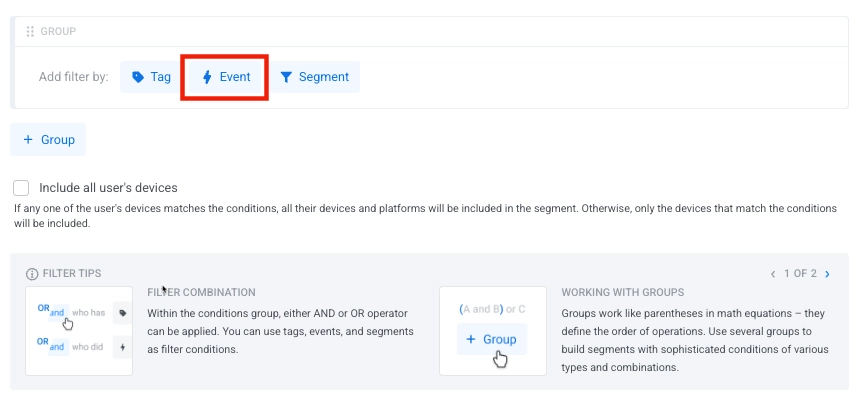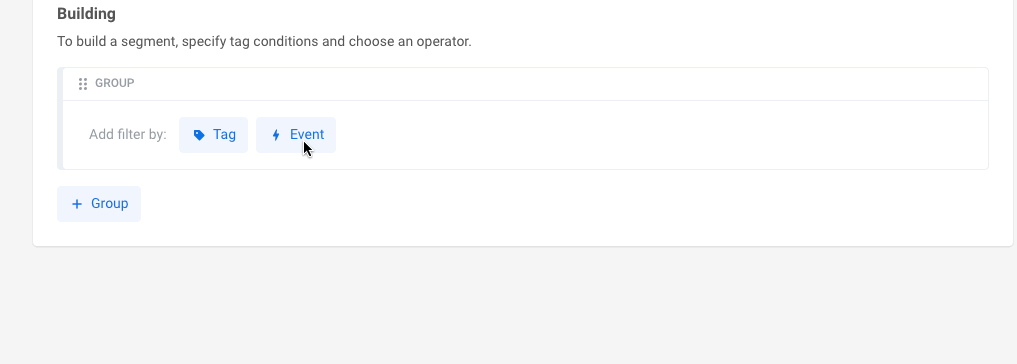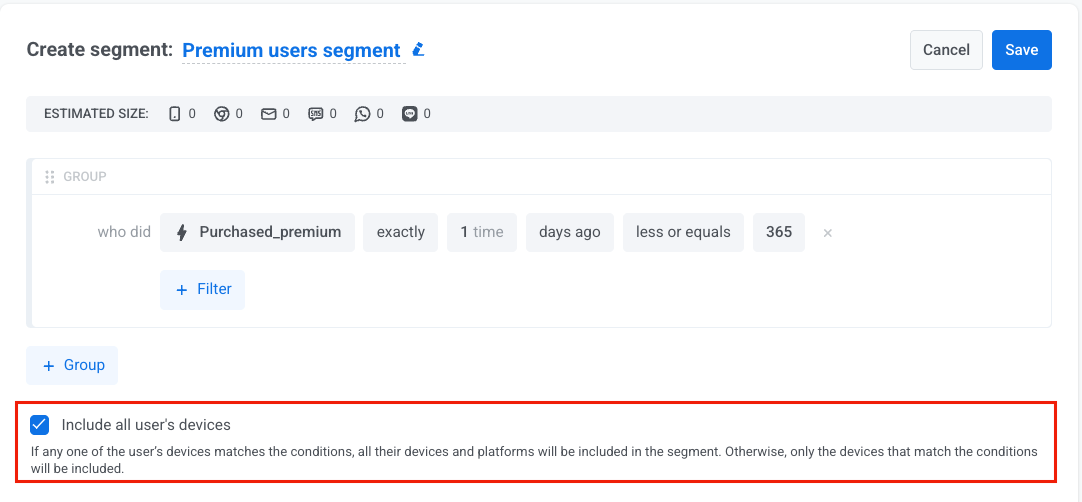Build segments by events
Ce contenu n'est pas encore disponible dans votre langue.
Event-based segmentation allows you to target users based on their actual behavior and actions within your app or website. This creates highly personalized and effective campaigns by focusing on user engagement patterns.
Build segments by events
Anchor link toTo build a segment by events:
- Hit Event in the Add filter by section.

- Select an event from the drop-down list.

- Indicate conditions for the selected event: the number of times it happened and a time frame.
When specifying a time frame for your segment, you can choose from two categories: Relative dates and Specific dates.
Relative dates
Anchor link toUse these options for dynamically updating time windows based on the current date:
| during the last N days | Includes events that occurred within the past N days |
| exactly N days ago | Targets users who triggered the event exactly N days ago |
| N or more days ago | Includes users who triggered the event at least N days ago |
| between N and M days ago | Defines a range of days before today |

Specific dates
Anchor link toUse these options to define fixed calendar-based filters:
| on a specific date | Includes users who triggered the event on a selected calendar date |
| on or after a specific date | Includes users who triggered the event starting from the selected date onward |
| on or before a specific date | Includes users who triggered the event up to and including the selected date |
| between dates | Includes users who triggered the event between two specific calendar dates |

- If you set several events as a segment condition, select an operator you’d like to use (AND/OR).

- Include all user devices
Enable this option to target a user across all their devices, not just the one that matched the segment condition. This ensures they receive your messages on every platform they use.
Enabled: If any of the user’s devices meet the condition (for example, purchase event, tag, behavior), all their devices across platforms are included in the segment.
Disabled: Only the devices that meet the condition are included in the segment.

Event-based segmentation examples
Anchor link toBelow are several practical scenarios illustrating how you can use event filters to create meaningful audience segments.
Frequent purchasers
Anchor link toGoal: Target highly engaged users who have made multiple purchases recently.
How to set up:
- Event:
Purchase_made - Condition: exactly or more
- Times:
3 - Time frame: during the last N days
- Value:
30
Use case: Send special offers or loyalty rewards to users who demonstrate frequent buying activity.
Viewed products but no purchase
Anchor link toGoal: Identify users who have shown interest but have not converted.
How to set up:
- Event 1:
Product_Viewed- Condition: exactly or more
- Times:
1 - Time frame: during the last N days
- Value:
7
- Event 2:
Purchase_made- Condition: never
- Time frame: during the last N days
- Value:
7
- Operator: AND
Use case: Send reminders, special offers, or personalized messages to users who browsed products but haven’t made a purchase yet.
Users engaged during a campaign
Anchor link toGoal: Target users who participated during a specific promotional period.
How to set up:
- Event:
Promotion_Click - Condition: exactly or more
- Times:
1 - Time frame: between dates
- Value:
"2024-01-01"and"2024-01-31"
Use case: Follow up with users who interacted with a past campaign to promote a related offer or gather feedback.
High-value actions over time
Anchor link toGoal: Identify users who performed a valuable event a certain number of times within a custom date range.
How to set up:
- Event:
Subscription_Renewal - Condition: exactly or more
- Times:
2 - Time frame: between dates
- Value:
"2024-01-01"and"2024-12-31"
Use case: Offer special recognition or advanced features to loyal subscribers who regularly renew their subscriptions.
Tips for event-based segmentation
Anchor link to- Use relative dates for ongoing campaigns that should stay updated with current user activity.
- Combine event filters with other criteria such as tags (e.g., user demographics, subscription status) or existing segments for more precise targeting. For example, you can filter users based on both event occurrence and user properties stored in tags to tailor your messaging even further.
- Periodically review and update your segment filters to adapt to changing user behaviors or business goals.